tow TOYOTA YARIS 2012 3.G Owners Manual
[x] Cancel search | Manufacturer: TOYOTA, Model Year: 2012, Model line: YARIS, Model: TOYOTA YARIS 2012 3.GPages: 400, PDF Size: 9.68 MB
Page 1 of 400
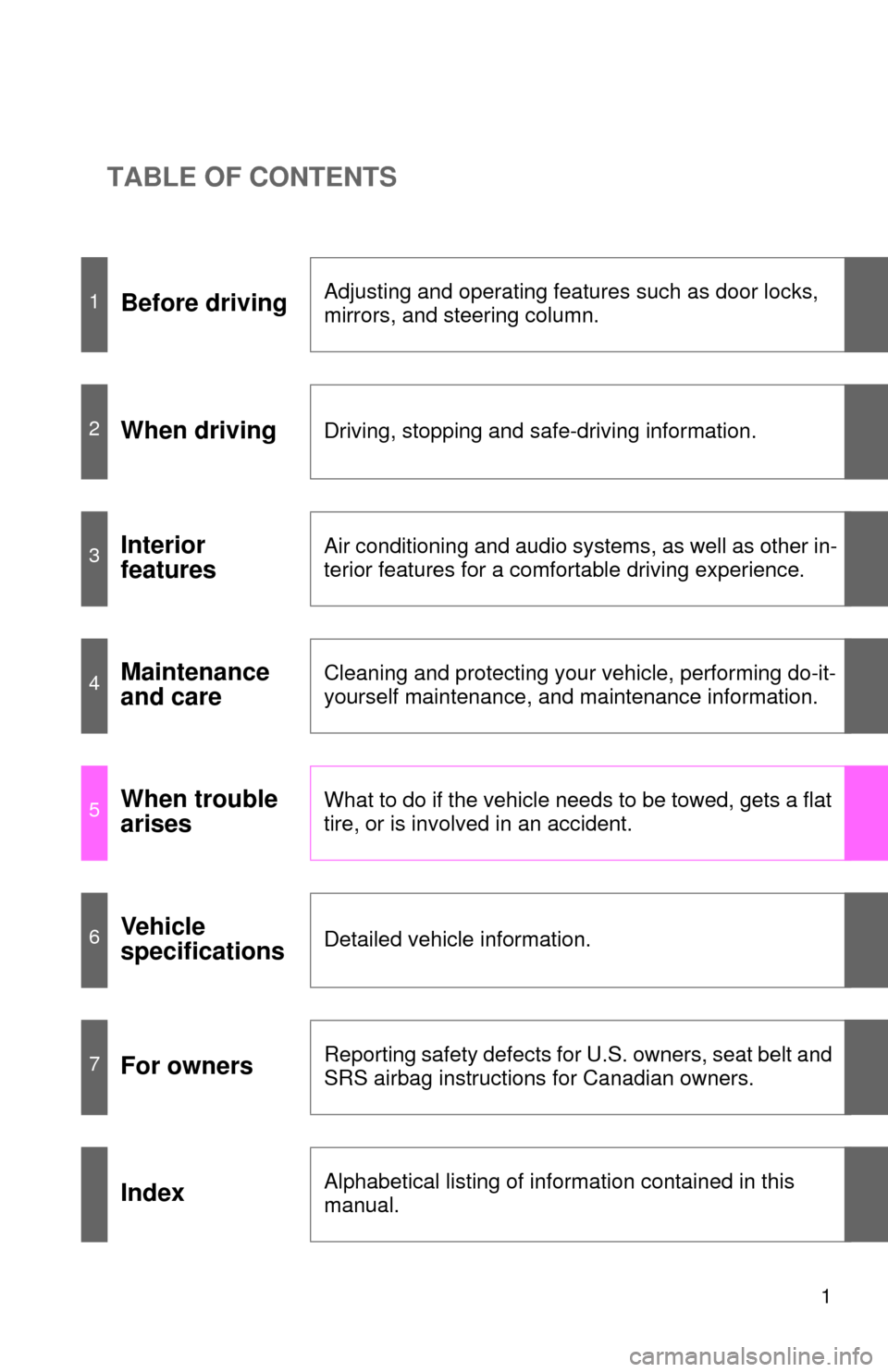
TABLE OF CONTENTS
1
1Before drivingAdjusting and operating features such as door locks,
mirrors, and steering column.
2When drivingDriving, stopping and safe-driving information.
3Interior
featuresAir conditioning and audio systems, as well as other in-
terior features for a comfortable driving experience.
4Maintenance
and careCleaning and protecting your vehicle, performing do-it-
yourself maintenance, and maintenance information.
5When trouble
arisesWhat to do if the vehicle needs to be towed, gets a flat
tire, or is involved in an accident.
6Vehicle
specificationsDetailed vehicle information.
7For ownersReporting safety defects for U.S. owners, seat belt and
SRS airbag instructions for Canadian owners.
IndexAlphabetical listing of information contained in this
manual.
Page 3 of 400

1
2
3
4
5
6
7
3
2-4. Using other driving systemsCruise control ...................... 158
Driving assist systems ........ 162
2-5. Driving information Cargo and luggage ............. 167
Vehicle load limits ............... 171
Winter driving tips ............... 172
Trailer towing (except 3-door models
for Canada) ....................... 176
Trailer towing (3-door models
for Canada) ....................... 177
Dinghy towing (vehicles with an automatic
transmission) .................... 187
Dinghy towing (vehicles with a manual
transmission) .................... 188
3-1. Using the air conditioning system and defogger
Air conditioning system ....... 192
Rear window and outside rear view mirror
defoggers .......................... 199
3-2. Using the audio system Using the AUX port/USB port ........................... 200
Using the steering wheel audio switches .................. 201 3-3. Using the interior lights
Interior lights list ................. 202
• Personal lights................... 203
• Interior light ...................... 203
3-4. Using the storage features List of storage features ....... 204
• Glove box ......................... 205
• Cup holders ...................... 205
• Bottle holders ................... 207
3-5. Other interior features Sun visors........................... 208
Vanity mirrors ..................... 209
Clock .................................. 210
Outside temperature display .............................. 211
Power outlet ....................... 213
Floor mat ............................ 214
Luggage compartment features ............................ 216
4-1. Maintenance and care Cleaning and protecting the vehicle exterior ........... 220
Cleaning and protecting the vehicle interior ............ 223
4-2. Maintenance Maintenance requirements .................... 226
General maintenance ......... 228
Emission inspection and maintenance (I/M)
programs .......................... 232
3Interior features
4Maintenance and care
Page 4 of 400

TABLE OF CONTENTSIndex
4
4-3. Do-it-yourself maintenanceDo-it-yourself service precautions ...................... 233
Hood................................... 236
Positioning a floor jack ....... 238
Engine compartment .......... 241
Tires ................................... 253
Tire inflation pressure......... 261
Wheels ............................... 265
Air conditioning filter ........... 268
Wireless remote control battery .............................. 270
Checking and replacing fuses ................................ 274
Light bulbs .......................... 286
5-1. Essential information Emergency flashers ........... 296
If your vehicle needs to be towed .......................... 297
If you think something is wrong ............................... 303
Fuel pump shut off system .............................. 304 5-2. Steps to take in an emergency
If a warning light turns on or a warning buzzer
sounds... ........................... 305
If you have a flat tire ........... 315
If the engine will not start .... 327
If the shift lever cannot be shifted from P (vehicles
with an automatic
transmission) .................... 328
If you lose your keys ........... 329
If the vehicle battery is discharged ........................ 330
If your vehicle overheats..... 334
If the vehicle becomes stuck ................................. 337
If your vehicle has to be stopped in
an emergency................... 339
6-1. Specifications Maintenance data (fuel, oil level, etc.) ........... 342
Fuel information .................. 353
Tire information................... 356
6-2. Customization Customizable features ........ 368
Items to initialize ................. 370
5When trouble arises
6Vehicle specifications
Page 32 of 400
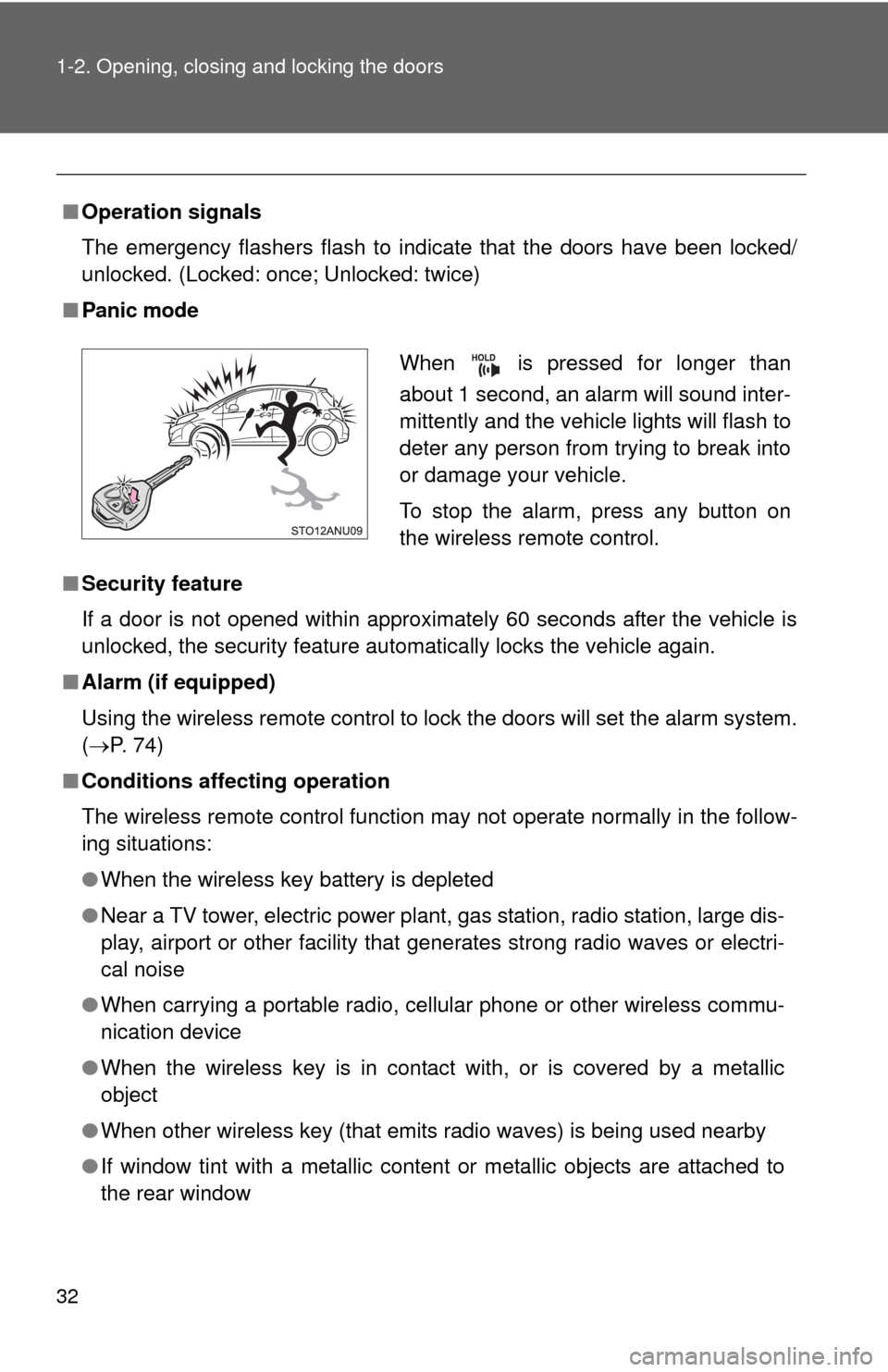
32 1-2. Opening, closing and locking the doors
■Operation signals
The emergency flashers flash to indicate that the doors have been locked/
unlocked. (Locked: once; Unlocked: twice)
■Panic mode
■Security feature
If a door is not opened within approximately 60 seconds after the vehicle is
unlocked, the security feature automatically locks the vehicle again.
■ Alarm (if equipped)
Using the wireless remote control to lock the doors will set the alarm system.
(P. 74)
■ Conditions affecting operation
The wireless remote control function may not operate normally in the follow-
ing situations:
●When the wireless key battery is depleted
● Near a TV tower, electric power plant, gas station, radio station, large dis-
play, airport or other facility that generates strong radio waves or electri-
cal noise
● When carrying a portable radio, cell ular phone or other wireless commu-
nication device
● When the wireless key is in contact with, or is covered by a metallic
object
● When other wireless key (that emits radio waves) is being used nearby
● If window tint with a metallic content or metallic objects are attached to
the rear window
When is pressed for longer than
about 1 second, an alarm will sound inter-
mittently and the vehicle lights will flash to
deter any person from trying to break into
or damage your vehicle.
To stop the alarm, press any button on
the wireless remote control.
Page 47 of 400
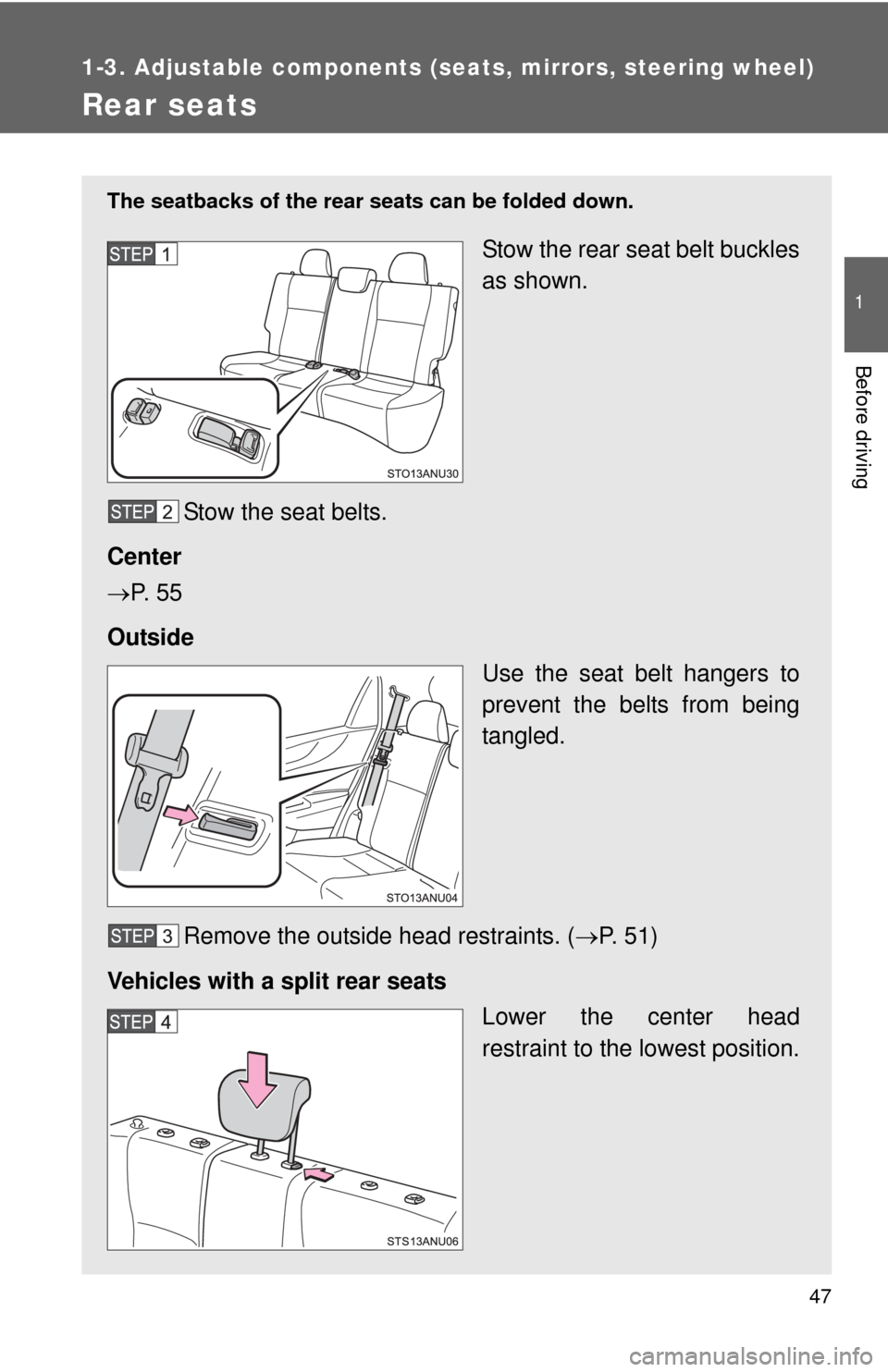
47
1
1-3. Adjustable components (seats, mirrors, steering wheel)
Before driving
Rear seats
The seatbacks of the rear seats can be folded down.
Stow the rear seat belt buckles
as shown.
Stow the seat belts.
Center
P. 5 5
Outside Use the seat belt hangers to
prevent the belts from being
tangled.
Remove the outside head restraints. ( P. 5 1 )
Vehicles with a split rear seats Lower the center head
restraint to the lowest position.
Page 50 of 400
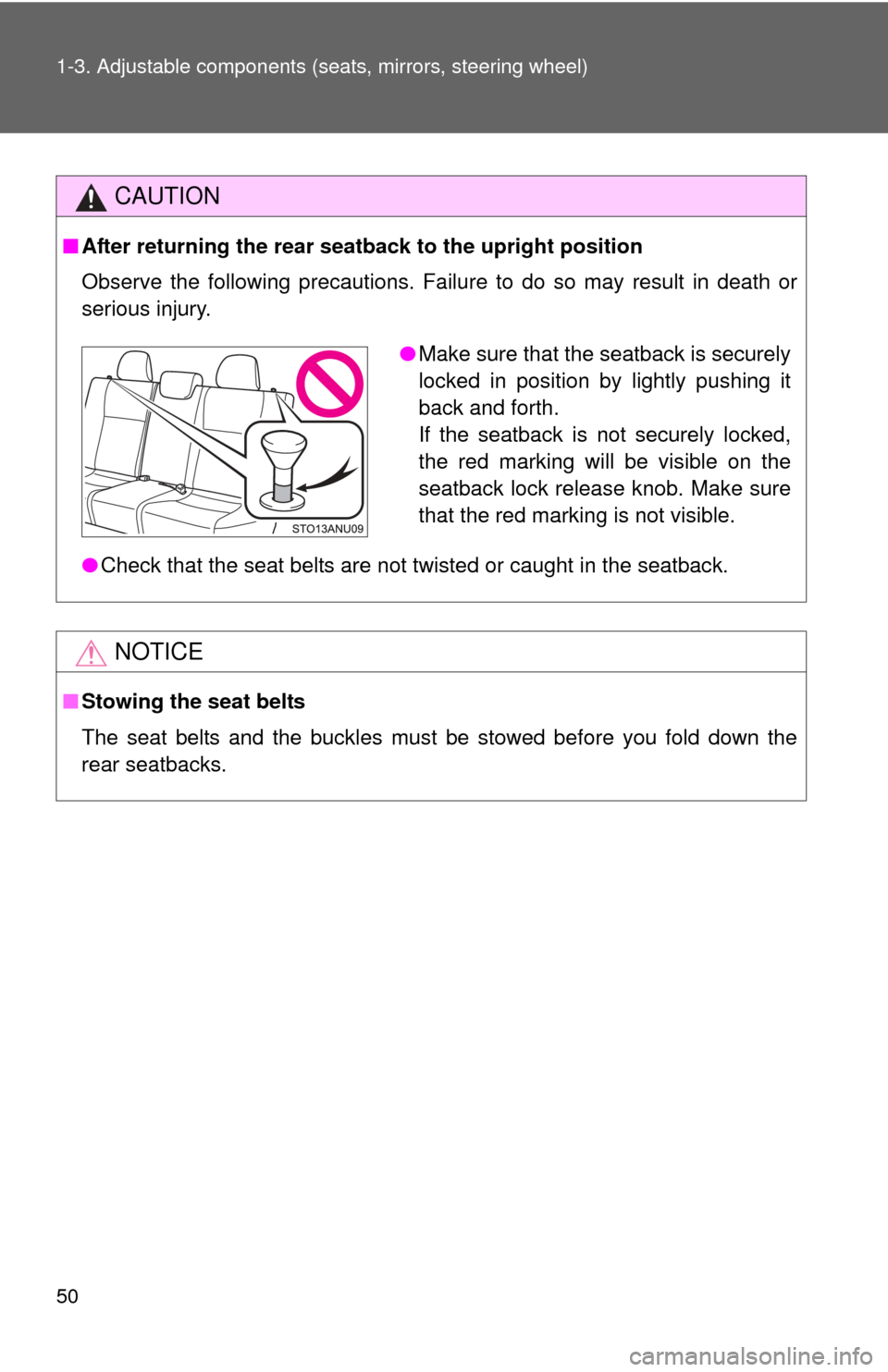
50 1-3. Adjustable components (seats, mirrors, steering wheel)
CAUTION
■After returning the rear seatback to the upright position
Observe the following precautions. Failure to do so may result in death or
serious injury.
●Check that the seat belts are not twisted or caught in the seatback.
NOTICE
■Stowing the seat belts
The seat belts and the buckles must be stowed before you fold down the
rear seatbacks.
●Make sure that the seatback is securely
locked in position by lightly pushing it
back and forth.
If the seatback is not securely locked,
the red marking will be visible on the
seatback lock release knob. Make sure
that the red marking is not visible.
Page 53 of 400
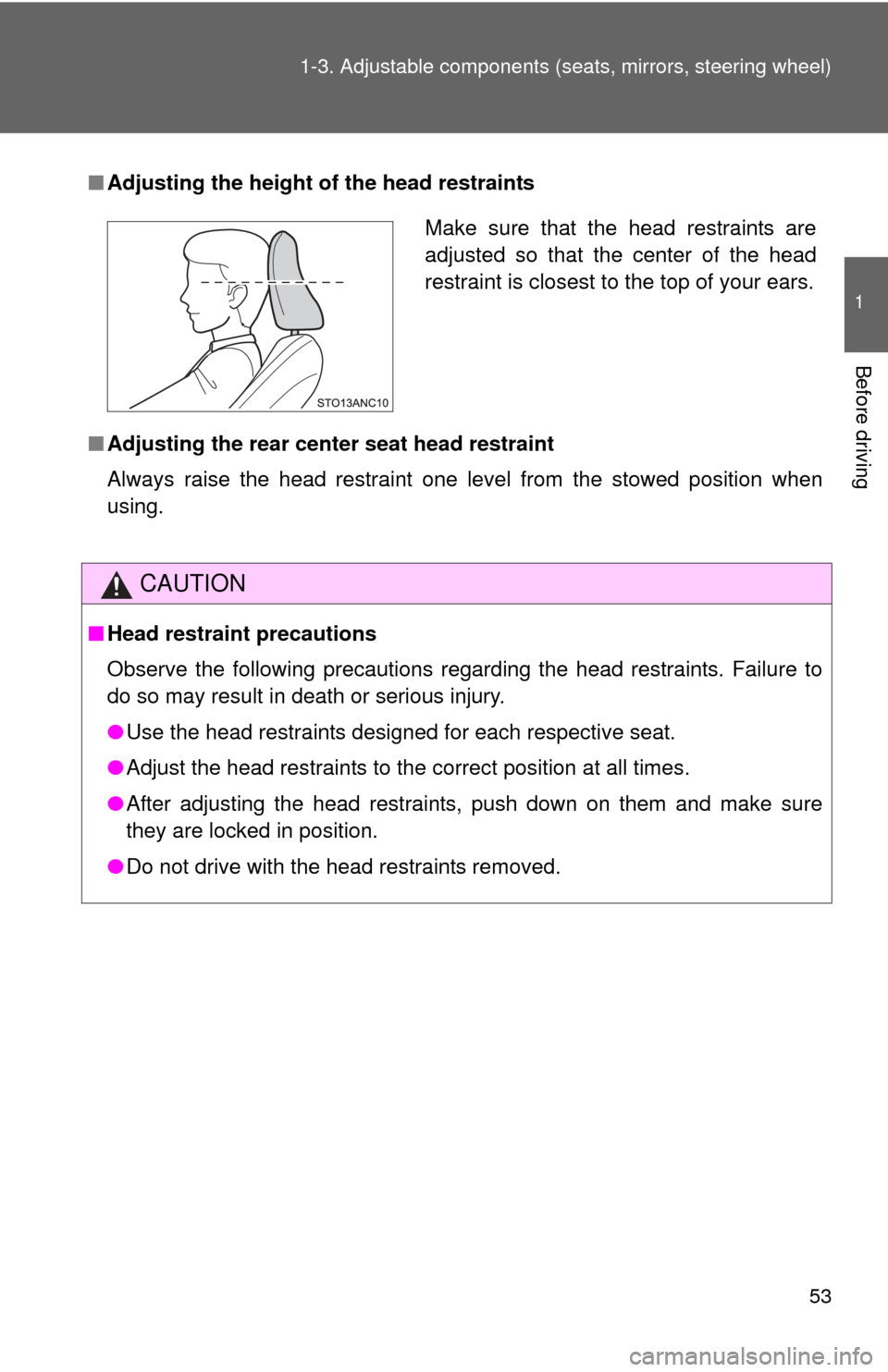
53
1-3. Adjustable components (s
eats, mirrors, steering wheel)
1
Before driving
■Adjusting the height of the head restraints
■ Adjusting the rear cent er seat head restraint
Always raise the head restraint one level from the stowed position when
using.
CAUTION
■ Head restraint precautions
Observe the following precautions regarding the head restraints. Failure to
do so may result in death or serious injury.
●Use the head restraints designed for each respective seat.
● Adjust the head restraints to the correct position at all times.
● After adjusting the head restraints, push down on them and make sure
they are locked in position.
● Do not drive with the head restraints removed.
Make sure that the head restraints are
adjusted so that the center of the head
restraint is closest to the top of your ears.
Page 55 of 400
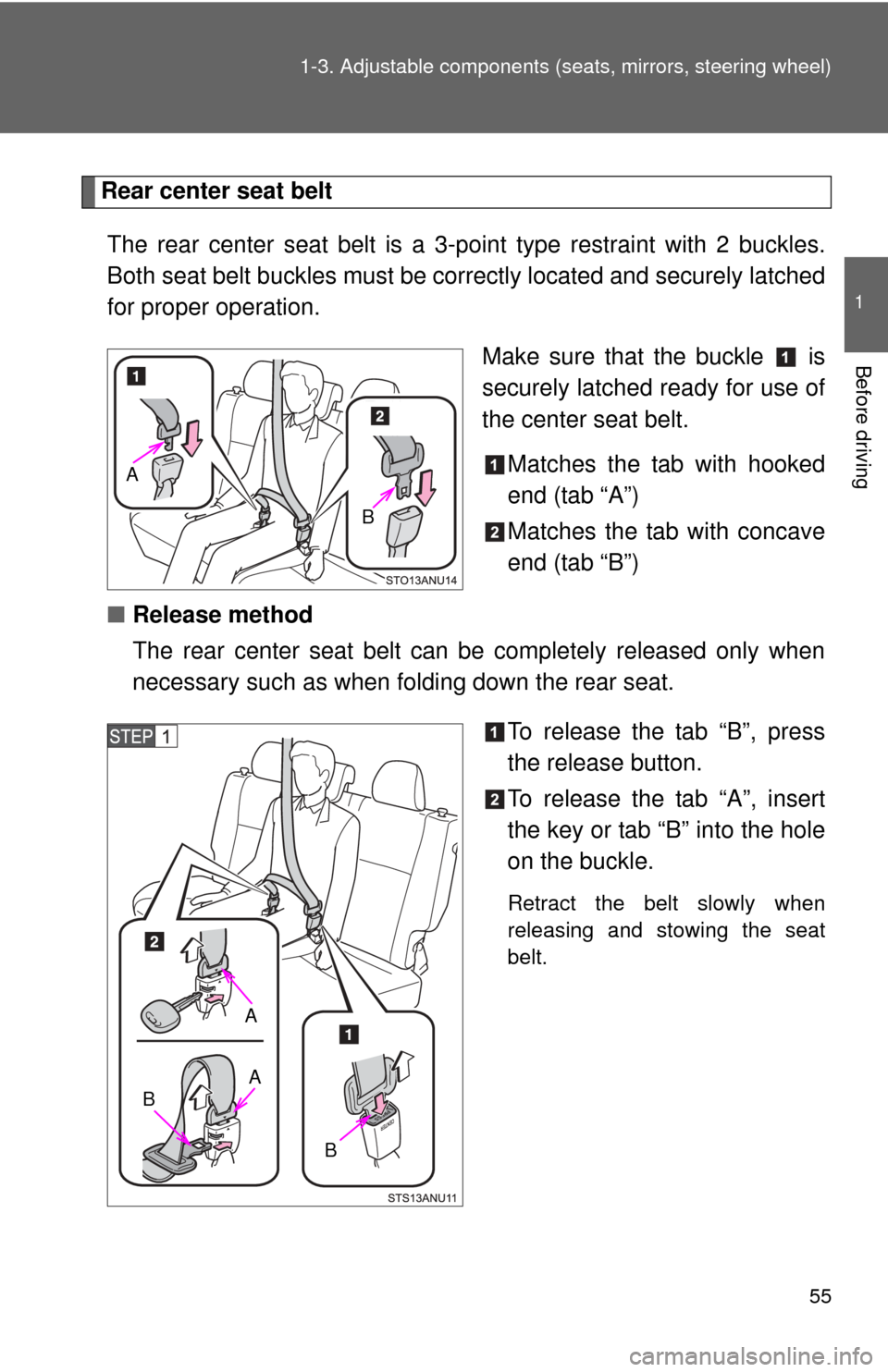
55
1-3. Adjustable components (s
eats, mirrors, steering wheel)
1
Before driving
Rear center seat belt
The rear center seat belt is a 3-point type restraint with 2 buckles.
Both seat belt buckles must be co rrectly located and securely latched
for proper operation.
Make sure that the buckle is
securely latched ready for use of
the center seat belt.Matches the tab with hooked
end (tab “A”)
Matches the tab with concave
end (tab “B”)
■ Release method
The rear center seat belt can be completely released only when
necessary such as when folding down the rear seat.
To release the tab “B”, press
the release button.
To release the tab “A”, insert
the key or tab “B” into the hole
on the buckle.
Retract the belt slowly when
releasing and stowing the seat
belt.
A
B
A
BA
B
Page 56 of 400
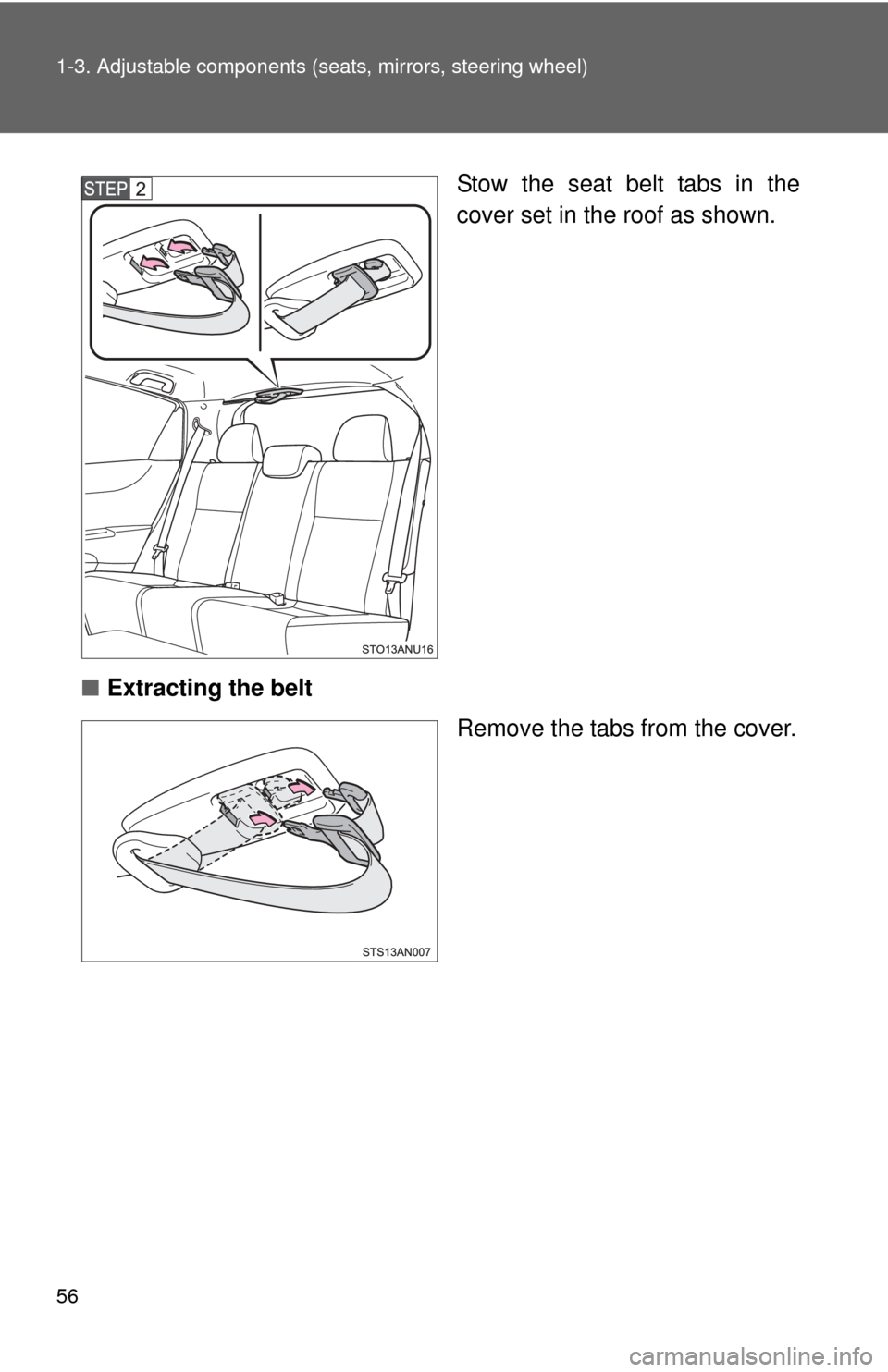
56 1-3. Adjustable components (seats, mirrors, steering wheel)
Stow the seat belt tabs in the
cover set in the roof as shown.
■ Extracting the belt
Remove the tabs from the cover.
Page 88 of 400

88 1-7. Safety information
CAUTION
■SRS airbag precautions
Observe the following precautions regarding the SRS airbags.
Failure to do so may cause death or serious injury.
●The driver and all passengers in the vehicle must wear their seat belts
properly.
The SRS airbags are supplemental devices to be used with the seat belts.
● The SRS driver airbag deploys with considerable force, and can cause
death or serious injury especially if the driver is very close to the airbag.
The National Highway Traffic Safety Administration (NHTSA) advises:
Since the risk zone for the driver’s airbag is the first 2 - 3 in. (50 - 75 mm)
of inflation, placing yourself 10 in. (250 mm) from your driver airbag pro-
vides you with a clear margin of safety. This distance is measured from the
center of the steering wheel to your breastbone. If you sit less than 10 in.
(250 mm) away now, you can change your driving position in several
ways:
• Move your seat to the rear as far as you can while still reaching the pedals comfortably.
• Slightly recline the back of the seat. Although vehicle designs vary, many drivers can achieve the 10 in. (250 mm) distance, even with the
driver seat all the way forward, simply by reclining the back of the seat
somewhat. If reclining the back of your seat makes it hard to see the
road, raise yourself by using a firm, non-slippery cushion, or raise the
seat if your vehicle has that feature.
• If your steering wheel is adjustable, tilt it downward. This points the air- bag toward your chest instead of your head and neck.
The seat should be adjusted as recommended by NHTSA above, while
still maintaining control of the foot pedals, steering wheel, and your view of
the instrument panel controls.